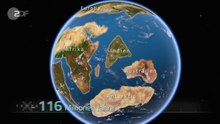Laurasia
Laurasia (made up of Laurentia and Asia , also Laurasia ) was the northern of the two large land masses into which the supercontinent Pangea broke up in the Mesozoic . The southern continent that re-emerged during this separation is called Gondwana . Laurasia essentially consisted of the Paleozoic "northern continents" Laurentia , Baltica , Sibiria and the large "East Asian cratons " of North China and South China. Laurasia had an extension of about 65 million km² in the Permian .
term
Around 1937 the South African geologist Alexander Du Toit refined the theory of the supercontinent Pangea by the German meteorologist Alfred Wegener and spoke of the two land masses Laurasia in the north and Gondwana in the south.
Proto-Laurasia
Although Laurasia is known as the Mesozoic continent - as part of Pangea - and is undisputed in the geological theory of plate tectonics , it is now assumed that its constituent parts formed a coherent large continent after the breakup of the supercontinent Rodinia - 800 mya . To avoid confusion with the Mesozoic Laurasia , it is also called Proto-Laurasia .
Probably broke Proto-Laurasia short time apart before it with the southern fragments of Rodinia back - East and West Gondwana - the Late Precambrian supercontinent Pannotia merged, which, however mya "only" 600 to 540, ie to the early Cambrian , had inventory .
Plate tectonic development up to the Triassic
According to more recent (from 2000) plate tectonic reconstructions, the "East Asian cratons" (including North China, South China, Indochina, Tarim and Lhasa) were at the Precambrian - Cambrian turn - around 540 mya - in the large southern continent Gondwana, which was already in existence at the time incorporated and possibly formed continental islands on an extensive shelf, whereas Baltica ("Ur-Europe"), Laurentia ("Ur-North America") and Sibiria (today's central Siberia, also called Angara Kraton) existed as separate continents north of Gondwana.
At the latest at the turn of the Silurian and Devonian - around 420 mya - Baltica and Laurentia collided on a broad front during the main phase of the Caledonian mountain formation (Scandic phase) and from then on formed a continent called Laurussia . In the further course of the Devonian, the East Asian cratons broke away from Gondwana and drifted north.
In the late Carboniferous - around 300 mya - Siberia initially collided with Kazakhstan, a microcontinent that may have only formed from an arch of an island southeast of Siberia in the course of the Old Paleozoic (see Chanty-Mansi Ocean ). Subsequently, Siberia-Kazakhstan collided on its western edge with Laurussia, which was already “docked” with Gondwana in the early Karbon . With that the formation of the supercontinent Pangea was effectively completed. Finally, in the early Triassic - around 250 mya - the East Asian cratons collided with the southeastern edge of Siberia-Kazakhstan, with which Laurasia - as part of Pangea - was essentially completed.
Development from the Jura
At the turn of the Triassic Jurassic - around 200 mya - Pangea began to break apart. The western Neotethys between the "European" (more precisely: "Iberian") and "African" part of Pangea opened further to the west, and between the "North American" and the "African" part of Pangea the central Atlantic opened up . As a result, Laurasia became an independent large "northern continent" in the further course of the Mesozoic. In the Eocene - around 50 mya - Laurasia broke up in the course of the opening of the North Atlantic into the western part now called North America ("Ex-Laurentia") and the eastern part now called Eurasia , the - also still in the Palaeogene - through the collision with Arabia and India large fragments of the former southern continent were annexed.
See also
Web links
Individual evidence
- ↑ Spencer G. Lucas, Joerg W. Schneider and Giuseppe Cassinis: Non-marine Permian biostratigraphy and biochronology: an introduction. In: Spencer G. Lucas, Giuseppe Cassinis and Joerg W. Schneider (Eds.): Non-Marine Permian Biostratigraphy and Biochronology. Geological Society, London, Special Publications, 265, 1-14, London 2006 PDF
- ↑ Alexander Du Toit, Our Wandering Continents (1937), quoted in Laurasia of the Encyclopædia Britannica


